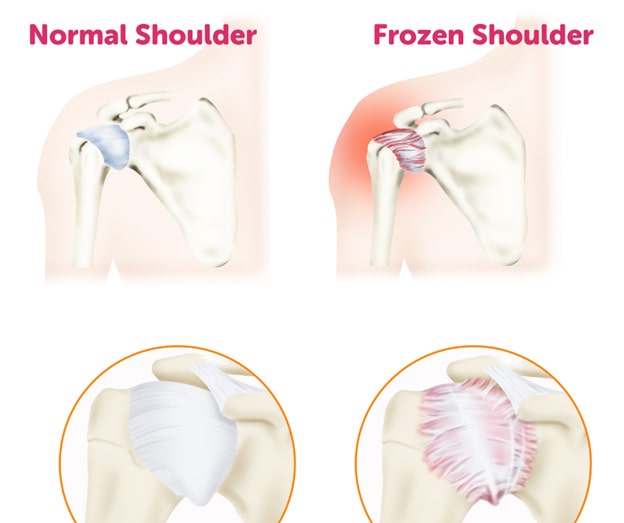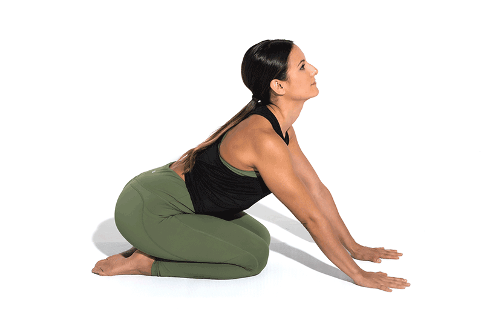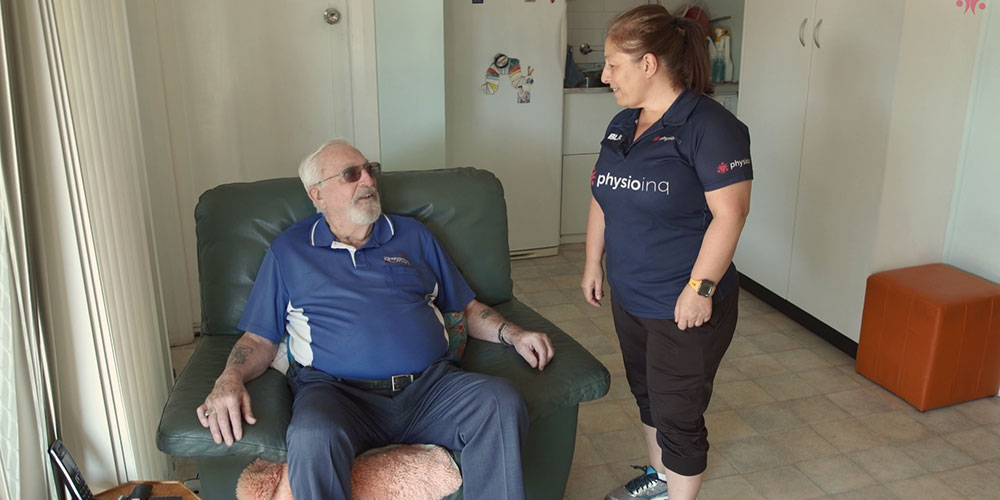Frozen shoulder is a complex and widely misunderstood shoulder condition. It’s completely debilitating, frustratingly long-lasting, and requires physiotherapy treatment.
Often confused with rotator cuff injuries, frozen shoulder causes pain and stiffness in the shoulder joint. But, physiotherapy can be effective in speeding up the recovery process.
Here, we’re sharing everything you need to know about frozen shoulder and how physiotherapy can help.
What is frozen shoulder?
Frozen shoulder is also known as adhesive capsulitis and is a frustrating source of shoulder pain. Although it only occurs in two to five per cent of the population, many with frozen shoulder are eager for relief.
The pain and stiffness associated with frozen shoulder occur when the shoulder capsule becomes inflamed and fibrotic adhesions limit shoulder movement.
When you have frozen shoulder, your joint capsule shrinks first before it thickens. The result is extreme pain and stiffness.
Frozen shoulder is often confused with rotator cuff injury. However, they’re quite different and require different treatment. In short, frozen shoulder means severe shoulder pain, loss of shoulder function, and stiffness.

Frozen Shoulder Causes
The causes of frozen shoulder are still heavily debated within the medical community. No one quite has the answer. Health conditions like diabetes, thyroid issues, and heart disease all show an increased likelihood of frozen shoulder. However, the correlation is not conclusive.
While medical professionals don’t necessarily understand the true causes of frozen shoulder, there are some strong risk factors associated with the condition.
Risk Factors for Frozen Shoulder
People who are at the highest risk of developing frozen shoulder tend to fall in the following categories:
- Diabetics
- Hypothyroidism sufferers
- Metabolic syndrome sufferers
- 40- to 60-year-olds
However, there is a slew of other risk factors for frozen shoulder including:
- Diabetes mellitus
- Stroke
- Thyroid conditions
- Shoulder injury
- Dupuytren disease
- Parkinson’s
- Complex regional pain syndrome
- Avascular necrosis
- Tuberculosis
- Shortness of breath
- Severe cough
- Breath quality compromises
- Metastatic disease
- Rheumatisms
- Multiple joint involvement
- Fever, chills, severe chronic pain
- History of cancer
- Systemic pathology
So, if you’re experiencing shoulder pain and stiffness and you have one or multiple risk factors for frozen shoulder, speak to a physiotherapist today for a diagnosis.
Frozen Shoulder Symptoms
There are three distinct stages of frozen shoulder symptoms: freezing, frozen, and thawing.
Stage 1: Freezing Phase
In this early stage of frozen shoulder, you’ll experience extreme shoulder pain and the onset of some stiffness. To think of it in terms of a freezing ice cube, this is the stage where your shoulder isn’t fully frozen but starting to freeze and solidify.
Stage 1 of frozen shoulder can last between 3 and 9 months. Although this is a long time to suffer, aggressive treatments are not recommended during this stage. However, pain relief treatments like anti-inflammatory medication will be your best bet during this painful period.
Stage 2: Frozen Phase
In the frozen stage, your shoulder will experience the most stiffness. Transitioning from stage 1 to stage 2 can be painful, but the dominating characteristic of stage 2 is the inability to move your shoulder as the pain will begin to subside in late stage 2.
Stage 2 of frozen shoulder can last between 9 and 15 months. In stage 2, physiotherapy can prove to be incredibly helpful in improving your range of motion with frozen shoulder while pain relief treatment can usually subside at this point.
Stage 3: Thawing Phase
The third stage of frozen shoulder is the thawing phase. Again, returning to the ice cube analogy, stage 3 refers to your stiffness and pain gradually melting away. Your shoulder’s range of motion will begin to return and your frozen shoulder will “thaw.”
The thawing phase can last between 15 to 24 months with physiotherapy, again, being the best form of treatment during stage 3.
On average, going through all three stages of frozen shoulder can take about 30 months. However, in these later stages, physiotherapy can speed up the process.
How is frozen shoulder diagnosed?
So, how do you know if you have frozen shoulder in the first place?
There are a few ways frozen shoulder is diagnosed. The first step is making an appointment with your physiotherapist. They will complete a thorough examination to determine whether you have frozen shoulder.
Common difficulties associated with frozen shoulder include:
- Inability to reach above shoulder height
- Inability to toss a ball
- Inability to reach for something quickly
- Inability to reach behind your back to clasp a bra or tuck a shirt, for example
- Inability to reach to your side and behind to put on a seatbelt, for example
- Inability to sleep or lie on your side
It’s easy to misdiagnose frozen shoulder for a rotator cuff injury and vice versa. So, it’s important to see a physiotherapist and ensure an accurate diagnosis.
Frozen Shoulder Treatment
As briefly mentioned above, frozen shoulder treatment varies depending on what stage you’re in.
During the freezing stage, your main treatment option will be pain relief including medication or corticosteroid injections. You might also take preventive measures in this stage to avoid making the condition worse.
In the frozen stage, gentle and very specific periarthritis shoulder exercises are the best plan of treatment. Because overdoing it can make your frozen shoulder worse, it’s incredibly important that you work with a physiotherapist during this stage.
Certain massage treatments (also to be performed by your physio) can also prove helpful as a treatment option for frozen shoulder in the frozen stage.
In the thawing stage, mobilisation and strengthening exercises for your shoulder are your best treatment options. Again, it’s important to work with a physiotherapist to ensure that you’re safely progressing towards recovery.
Overall, working with a physio for frozen shoulder has been seen to increase the speed of recovery substantially.
Shoulder surgery is another treatment option for frozen shoulder in cases that cannot be treated through physiotherapy. However, post-capsular surgery for frozen shoulder will often require physiotherapy in the recovery phase.
Frozen Shoulder Exercises
Frozen shoulder or adhesive capsulitis exercises start out with stretching and move onto strengthening. Your physiotherapist will provide you with a tailored exercise plan to treat your frozen should most effectively.
Below, we’re going over some of the most common encapsulated shoulder exercises.
Start with some stretches.
Pendulum Stretch
- Relax your shoulders and lean over slightly, letting your arm hang loose.
- Swing your arm in a small circle, performing ten rotations in each direction per day.
- As your mobility increases, gently increase the circle’s diameter and add weights for a deeper stretch. Just don’t overdo it!
Towel Stretch
- Hold a tea towel behind your back, grabbing opposite ends with each hand keeping the towel parallel to the ground.
- Lift the elbow of your unaffected arm to gently stretch your frozen shoulder.
Finger Walk
- Stand facing a wall at a distance of about three-quarters of your arm length.
- Place your fingers of the affected arm on the wall and walk your fingers up the wall as high as you can manage. Use your finger muscles instead of your shoulder muscles to feel a stretch in your shoulder.
- Use your unaffected arm to slowly release and repeat 10 to 20 times per day.
Cross-Body Reach
- Either sitting or standing, use your unaffected arm to lift your affected arm by the elbow.
- Reach the affected arm across your body and use your unaffected arm to apply gentle pressure and stretch your shoulder.
- Hold for 15 to 20 seconds 10 to 20 times per day.
Then, you can add on some strengthening capsulitis shoulder exercises.
Outward Rotation
- With your elbows bent at a 90-degree angle and tucked towards your ribs, hold each end of a resistance band in each hand.
- Rotate the lower part of your affected arm outwards and hold for five seconds. Repeat 10 to 15 times.
Inward Rotation
- Attach a resistance band to the doorknob of a closed door.
- Grab the band with your affected arm, elbow bent 90 degrees and close to your ribs.
- Rotate the lower part of your arm towards your body and hold for five seconds. Repeat 10 to 15 times.
Reminder: These exercises are always safest done under the supervision and instruction of a physiotherapist.
Is physiotherapy good for frozen shoulder?
The short answer: yes, physiotherapy is good for, if not essential to the treatment of frozen shoulder. Apart from surgery or just waiting it out, physiotherapy can effectively treat frozen shoulder to speed up the recovery process immensely.
Sick of dealing with pain and stiffness in you’re shoulder? Concerned that you might have frozen shoulder? Call Physio Inq today and book an appointment to see one of our expert physiotherapists.
We have countless convenient clinics Australia-wide or our amazing mobile physio services can bring relief to you. Don’t suffer from frozen shoulder any longer than you need to you. Contact Physio Inq now!
Additional Resources
- Controlled Articular Rotations (CARS) – What They Are & Why You Should Do Them
- Is There A Way To Help My Chronic Shoulder Instability?
- The Cause Of Shoulder Instability
Date Published: Monday, March 15, 2021
Locate a Mobile Physiotherapy
Service Near me
Get the experience & convinence you deserve to support your or a loved one's allied health needs.
Our Mobile Physiotherapy team are currently serving & taking appointments in the following states and regions in Australia:
New South Wales
- Blacktown
- Blue Mountains
- Campbelltown And Macarthur
- Canterbury-Bankstown
- Eastern Suburbs Sydney
- Georges River
- Hawkesbury
- Inner East Sydney
- Inner West Sydney
- Lake Macquarie
- Lower North Shore
- Newcastle
- Northern Beaches
- North Sydney
- Parramatta
- Penrith
- Southern Highlands
- South West Sydney
- Sutherland Shire
- Sydney CBD
- The Hills Shire
- Upper North Shore
- Waverley
- Wollongong
Tasmania
Victoria
Need to get into direct contact with ur Client Services team? We're all ears. Call our team directly on 1300 731 733












